Trier Roman ruins: Germany’s Roman capital
It’s perhaps surprising to hear that there are significant Roman ruins in Germany: in Trier, which is in the western part of the country right near the border with Luxembourg. The Trier Roman ruins are particularly surprising just because of how many there are, and how well-preserved some of them are, especially one called the Porta Nigra. The Roman ruins, along with the Cathedral of St. Peter and the Church of Our Lady, together make up a UNESCO World Heritage site.
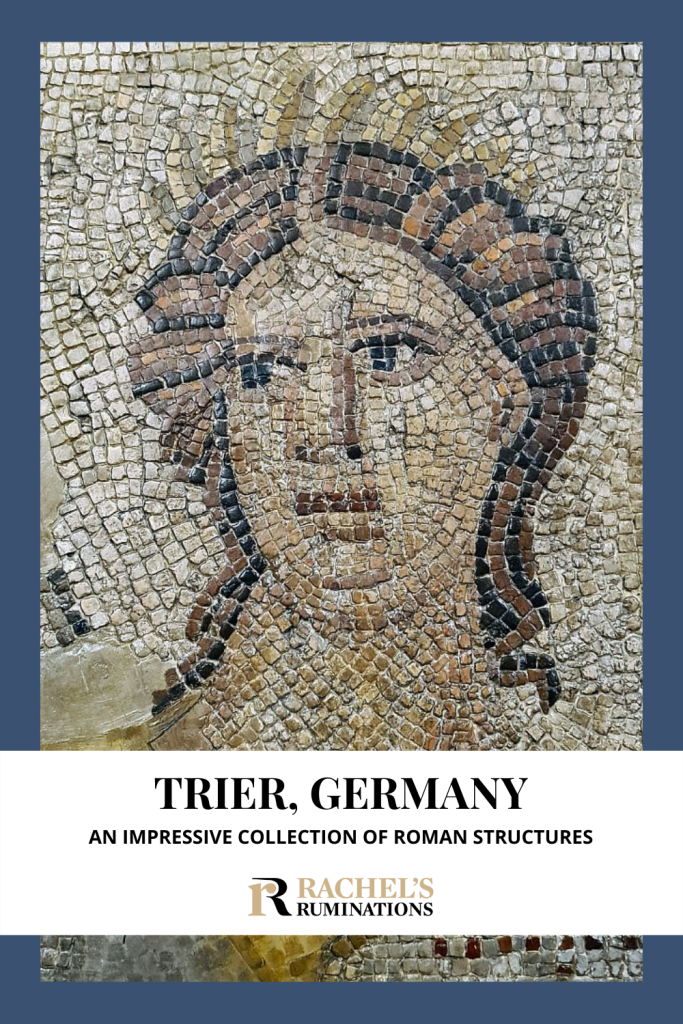
Disclosure: This article contains affiliate links. If you click on an affiliate link and make a purchase, I will receive a small commission. This will not affect your price.
Why are there Roman ruins in Trier, Germany?
Trier, in the southwest of Germany on the Moselle River, became a Roman city starting from the 1st century AD. It was called Augusta Treverorum; the Treveri were a Celtic tribe that had lived there for centuries and “Augusta” refers to Emperor Augustus.
By the end of the 3rd century AD, the city was an important trading center. It gained more significance under Roman Emperor Constantine the Great, when Christianity made its way into this part of Europe. The Franks took Trier from the Romans in 459 AD, and it eventually became part of the early Holy Roman Empire.
The main things to see in Trier have to do with its Roman period, both pre-Christian and under Constantine. Some of these sights are quite remarkable.
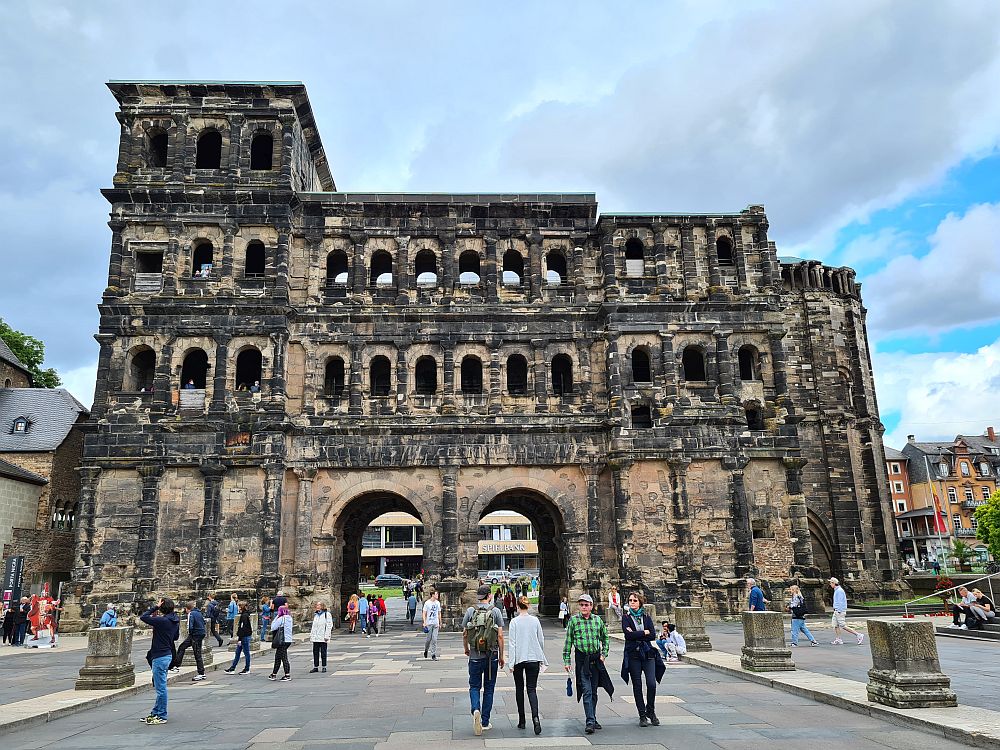
The Porta Nigra
The real highlight of the Trier Roman ruins, and perhaps of all Roman ruins in Germany, is the Porta Nigra, which translates as “black gate.” Dating to the 2nd century AD, it was one of four gates in the roughly rectangular wall around the city.
All four gates later became convenient sources of building materials, but fortunately this one survived because of a religious hermit called Simeon, who moved into the gate in the 11th century. After his death, he was declared a saint and the local bishop ordered that the gate be converted to a church. It eventually became a double-decker church. The first floor was a church for the masses, while the second (top) level served the religious community of the monastery next door.
In order to turn the gate into a church, the gate itself was walled up using earth. A side effect of this decision was that the earth served to preserve the exterior. When Napoleon briefly conquered Trier, he ordered the earth cleared, and the Prussian rulers who took over next finished the job.
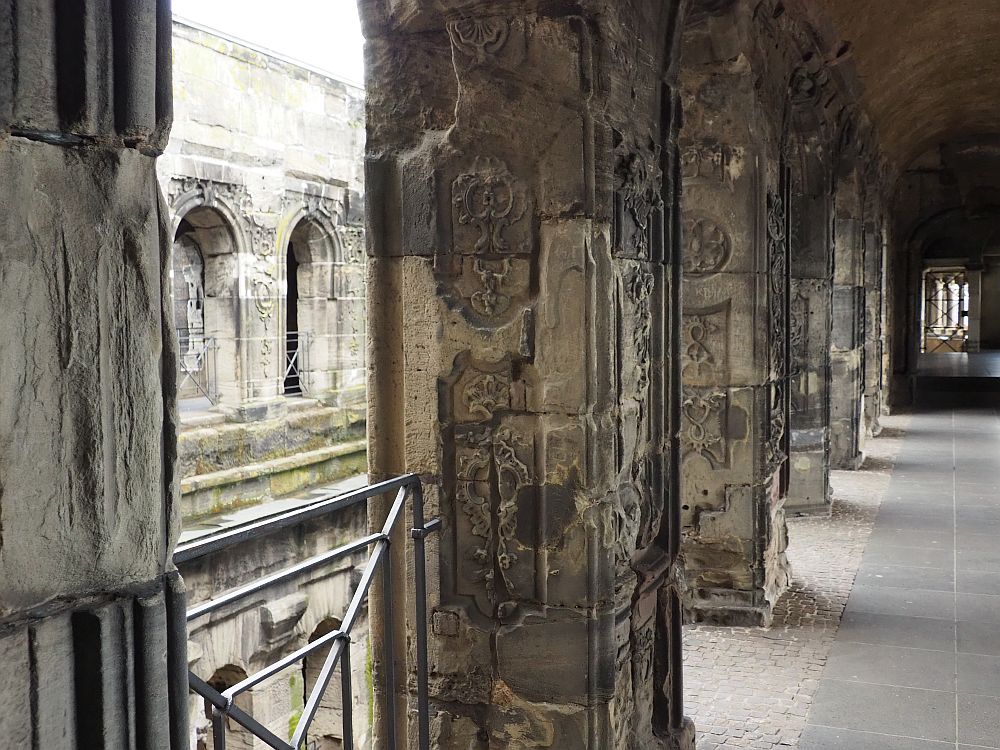
What you can visit today is more or less what it was like as a city gate in layout. Yet the signs of its later use as a church are everywhere, particularly in the baroque carvings inside the walls and several changes to allow, for example, an exit to the attached monastery.
The Porta Nigra is only wheelchair-accessible on the ground floor. Make sure if you visit to pick up the information sheet included with your admission; it really helps make clear what you are seeing as you explore the building.
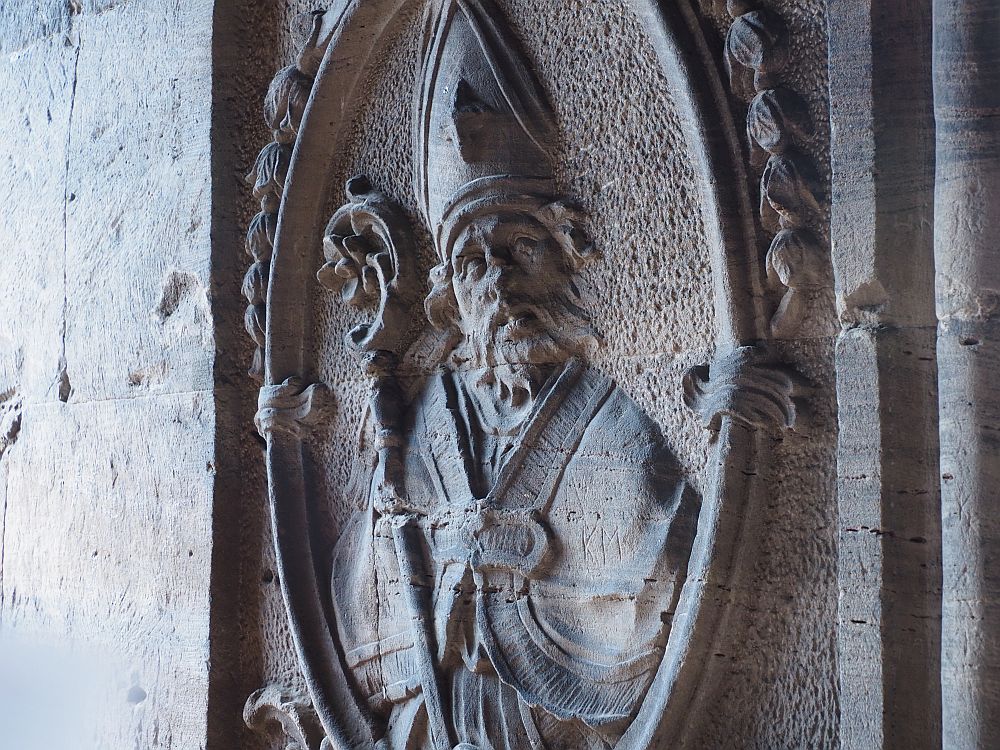
Porta Nigra: Simeonstraße 60. Open daily all year: April to September, 9:00-18:00; October and March 9:00-17:00; November-February 9:00-16:00 . Admission: Adults €4, children 6-18 €2.50. Website.
Three Roman baths
Any self-respecting Roman city had to have public baths. Trier was a significant city, after all, with a population that may have been as high as 100,000 in the Roman period, not much different from its current population of about 110,000. Three of these baths have been excavated and can be viewed:
1. The Imperial Baths (Kaiserthermen)
The Imperial Baths date from the period when Trier was the capital of the entire western portion of the Roman Empire, reaching all the way from here to include what is now Britain and Spain. Begun in the early 4th century, it was meant, as the name implies, to serve the Emperor. However, imperial politics shifted the capital to Arles, and construction stopped, only to restart in 360 AD. Emperor Valentinian I ordered a piece of it torn down, but the rest was completed to serve as a reception hall, not a bath. Other buildings rose on the site over the succeeding centuries, but were destroyed in World War II, which meant that in the 1960s what remained could be excavated and studied.
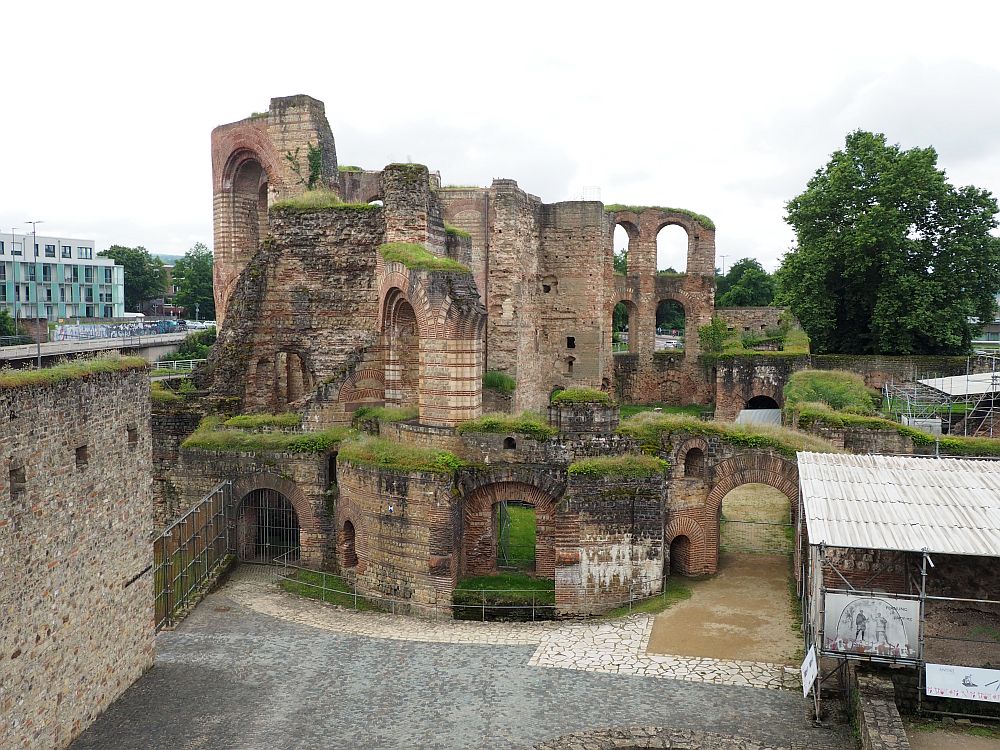
The original plan can be discerned in what is left of the original baths. There was a frigidarium (cold bath), a tepidarium (warm bath) and a caldarium (hot bath) as well as two pools. Little remains but some extensive tunnels of the underground service level, where the water was heated for the baths. One rather grand-looking section with a curved wall survives because it was used in the Middle Ages as part of a castle and part of a city gate.
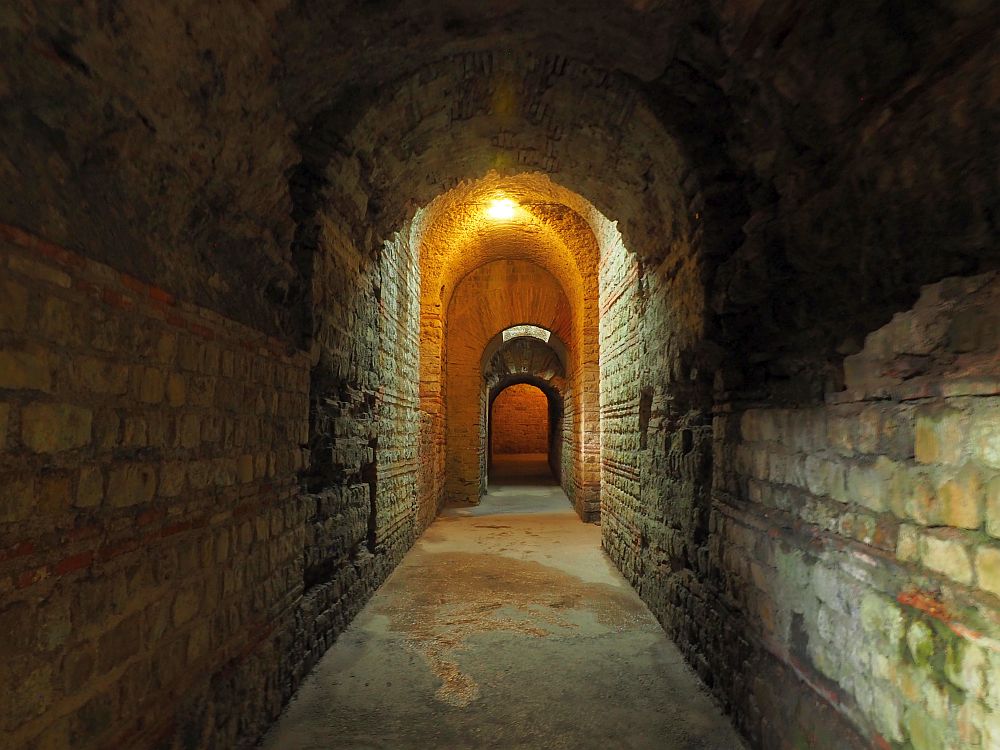
Kaiserthermen: Weberbach 41. Open daily all year: April to September, 9:00-18:00; October and March 9:00-17:00; November-February 9:00-16:00 . Admission: Adults €4, children 6-18 €2.50. Website.
2. The Barbara Baths
The Barbara Baths are older than the Imperial Baths, dating to the 2nd century. These were public baths, once the second largest in the whole Roman Empire. Today there’s not very much to see, but a pathway crosses what remains, with informational signs explaining what is visible.
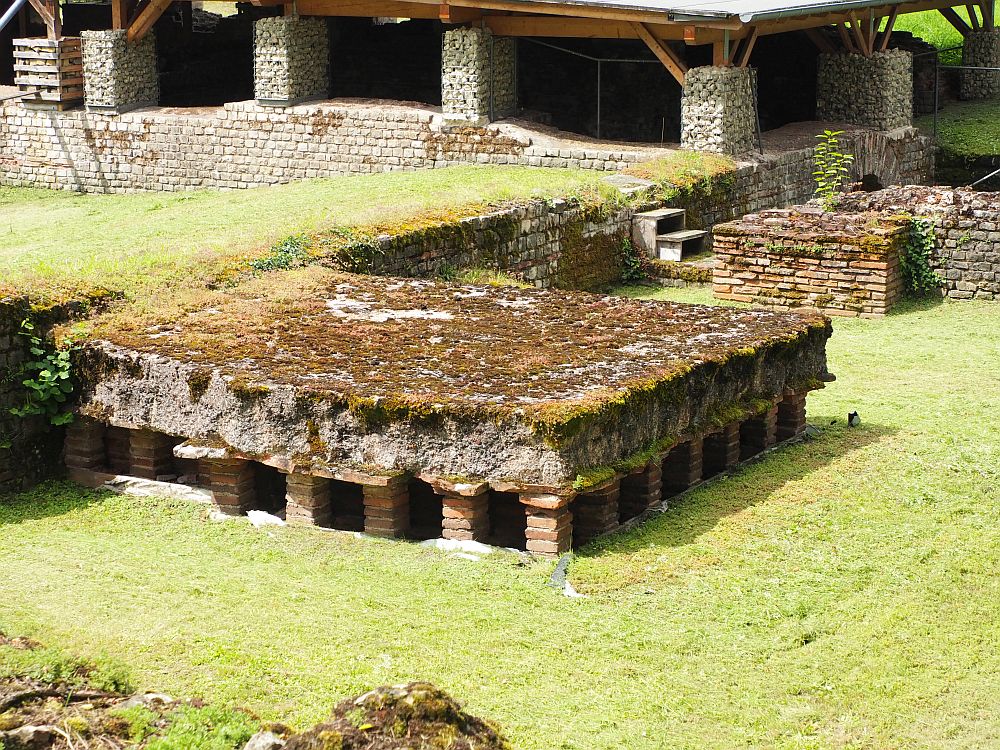
Barbarathermen: Südallee, in the block nearest the river. Open daily all year: April to September, 10:00-18:00; October and March 10:00-17:00; November-February 10:00-16:00 . Admission: Adults €4, children 6-18 €2.50. Admission: free. Website.
3. Thermen am Viehmarkt (a.k.a. the Forum Baths)
The Thermen am Viehmarkt is an excavated site inside a modern glass cube of a building. Dating to the 3rd-4th century AD, in the succeeding centuries the site became a source of construction materials and was used as a Jewish cemetery and a monastery garden. Later it was home to a cattle market; viehmarkt means “cattle market.”
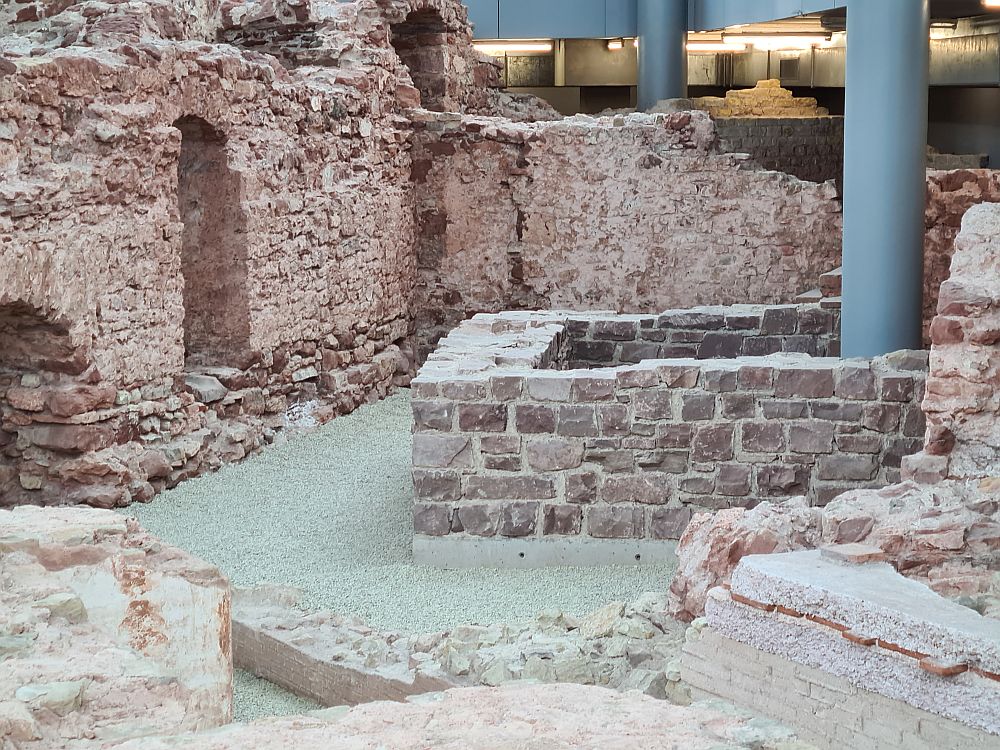
Today you can walk among the ruins, or rather a small part of them, where signs explain what you are seeing and what it once was.
Thermen am Viehmarkt: Viehmarktplatz 2. Open daily all year: April to September, 9:00-18:00; October and March 9:00-17:00; November-February 9:00-16:00. Admission: Adults €4, children 6-18 €2.50. Website.
And speaking of baths, there are much more modern thermal spa towns not too far away from Trier. Read about them here:
The Amphitheater
The Roman Amphitheater, which dates to the 1st century AD, could once seat 20,000 people. Earth embankments around the arena accommodated the spectators, who entered through one of two narrow passages called vomitoria leading through the embankments to the stands. A vomitorium isn’t a place to vomit but rather a place that crowds of people packed into, so that they “vomited” out into the stands or back out to go home.
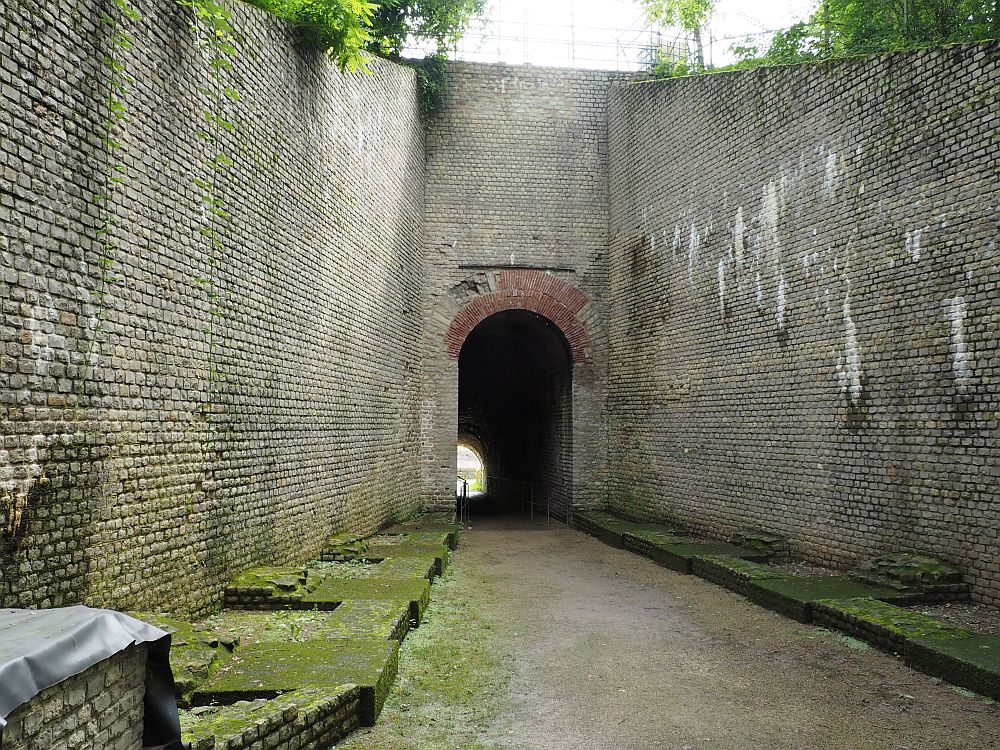
Both vomitoria led in the direction of the city, which makes sense since that’s where the people who attended events in the amphitheater lived. The Emperor’s box stood on top of the embankment between the two vomitoria. The original Roman city wall ran right along this side of the amphitheater, with a tower on top of each vomitorium. Inside the vomitoria you can still see some traces of Roman wall plaster and paint.
Other rooms and passages under the embankments were used for the gladiators, animals, musicians, and other performers. Under the floor of the arena was a cellar with a lift platform for quick scene changes.
According to an informational sign at the site, events had a very consistent order: first, in the morning, were the animal hunts, in which exotic animals like lions or bears would be hunted within the arena. At midday, executions were carried out. The main event, gladiatorial battles, followed in the afternoon.
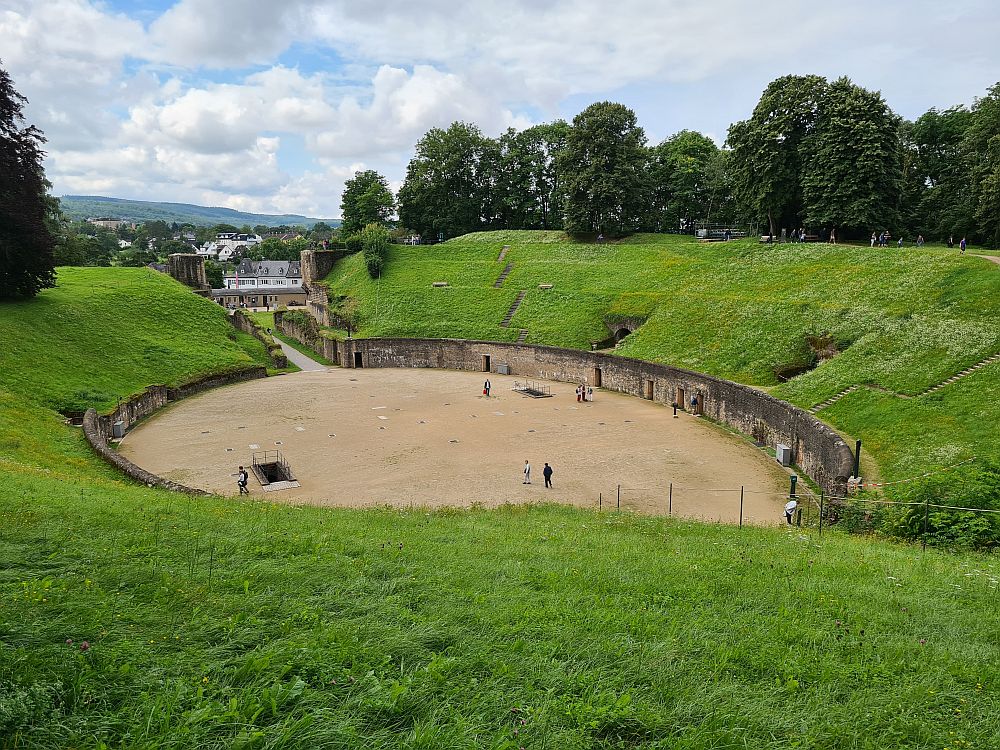
Today the seats are missing, removed for construction material in the Middle Ages. Yet enough of the general form remains to give a good idea of how it once looked. You can walk around the top of the embankments and explore the underground cells, cages and passages.
Amphitheater: Olewiger Straße 25. Open daily all year: April to September, 9:00-18:00; October and March 9:00-17:00; November-February 9:00-16:00. Admission: Adults €4, children 6-18 €2.40. Website.
The Moselle Bridge
This Roman Bridge in Trier is the oldest bridge in Germany and still rests on nine pillars dating from the 2nd century AD. The upper part of the bridge has been rebuilt twice since then, but it’s pretty impressive that these nine original supports are still intact and doing their job, even supporting vehicle traffic.
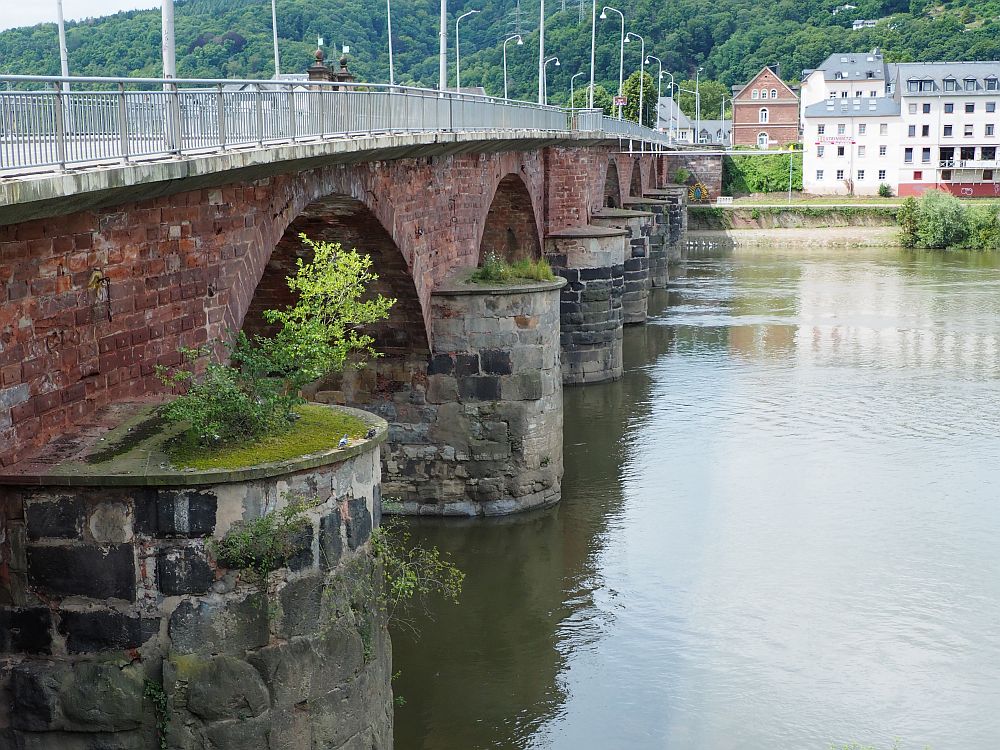
Moselle Bridge: Römerbrücke, which carries the Karl-Marx-Straße. A public bridge, no admission fee.
The Basilica (a.k.a. Aula Palatina)
This Basilica is also known as the Basilica of Constantine because Emperor Constantine I commissioned it in the 4th century. He was the first Christian Roman ruler and was responsible for the increase in tolerance for Christianity within the Empire. Yet the building’s original purpose was to be an Imperial throne room, part of a larger palace complex. It became a church possession in the 10th century, then later became part of a newer palace. It wasn’t converted to a church until the mid-19th century. Today it is home to the Protestant Evangelical Church of the Redeemer.
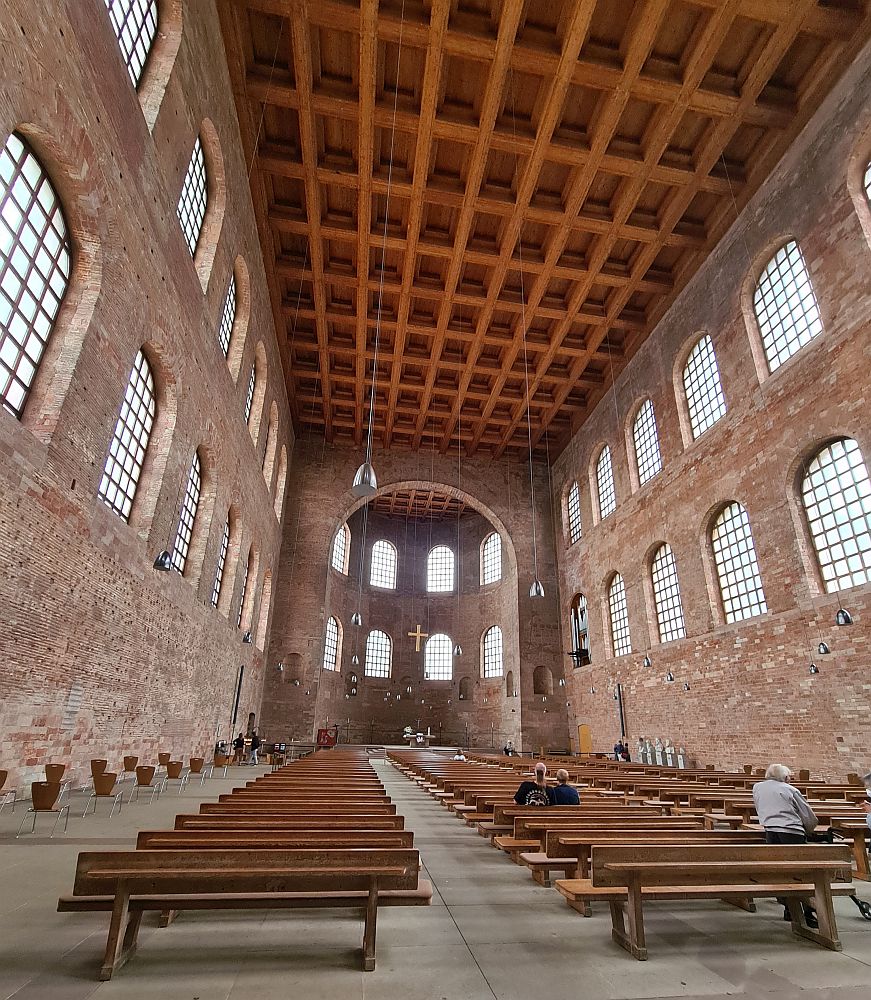
The Basilica impresses based on its sheer size, especially when you consider how old it is. Alterations changed it over ensuing centuries, but a 19th-century restoration returned it to its original shape and size. It’s 33 meters tall (108 feet) and 71 meters long (233 feet) and entirely brick. The walls are more than 3 meters (10 feet) thick too. Originally the inside walls would have been covered in marble and probably highly decorated, but today it’s all plain brick.
Aula Palatina: Konstantinplatz 10. Open April to October, Monday-Saturday 10:00-18:00; Sunday 14:00-18:00. In November and January-March, open Tuesday-Saturday 10:00-12:00 and 14:00-16:00; Sunday 14:00-15:00. In December open Monday-Saturday 10:00-12:00 and 14:00-16:00; Sunday 14:00-15:00. Closed during church services. No admission fee. Website.
The Trier Cathedral of St. Peter (Trier Dom)
This is the oldest church in Germany, with the oldest part dating to the 4th century. There were many changes over the succeeding centuries, and the church grew to its medieval Romanesque form, much of which is still viewable in the choir screens, some sculptures and the graves. New Baroque additions, including some very ornate altars, came in the 17th-18th century.
Trier Cathedral: Liebfrauenstraße 12. Open November-March Monday-Sunday 6:30-17:30. April-October Monday-Sunday 6:30-18:00 and Sunday 11:30-18:00. Closed during mass. Free admission. Website.
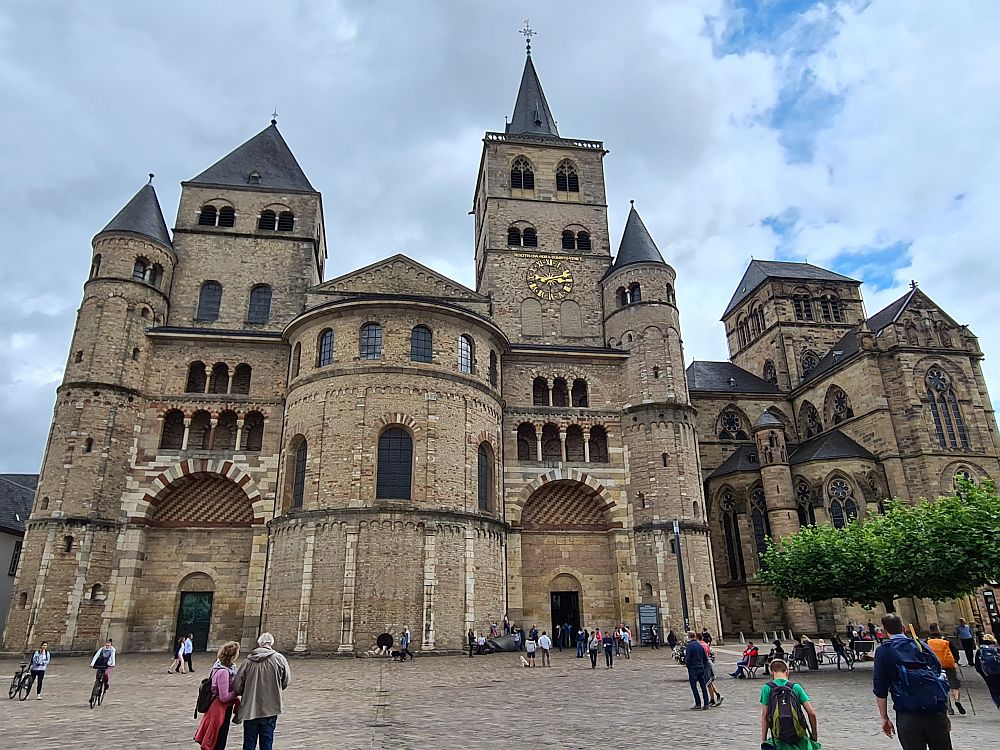
The Church of Our Lady (Liebfrauenkirche)
The Church of Our Lady stands right next to Trier Cathedral. It is the oldest Gothic church in Germany, “the earliest church built in French High Gothic style outside France” according to UNESCO. It was completed in the 13th century.
What’s unusual, and quite beautiful, about this church is its shape: it’s round. Excavations underneath the floor of the church – closed to the public – have shown that an early Roman church once stood on this spot.
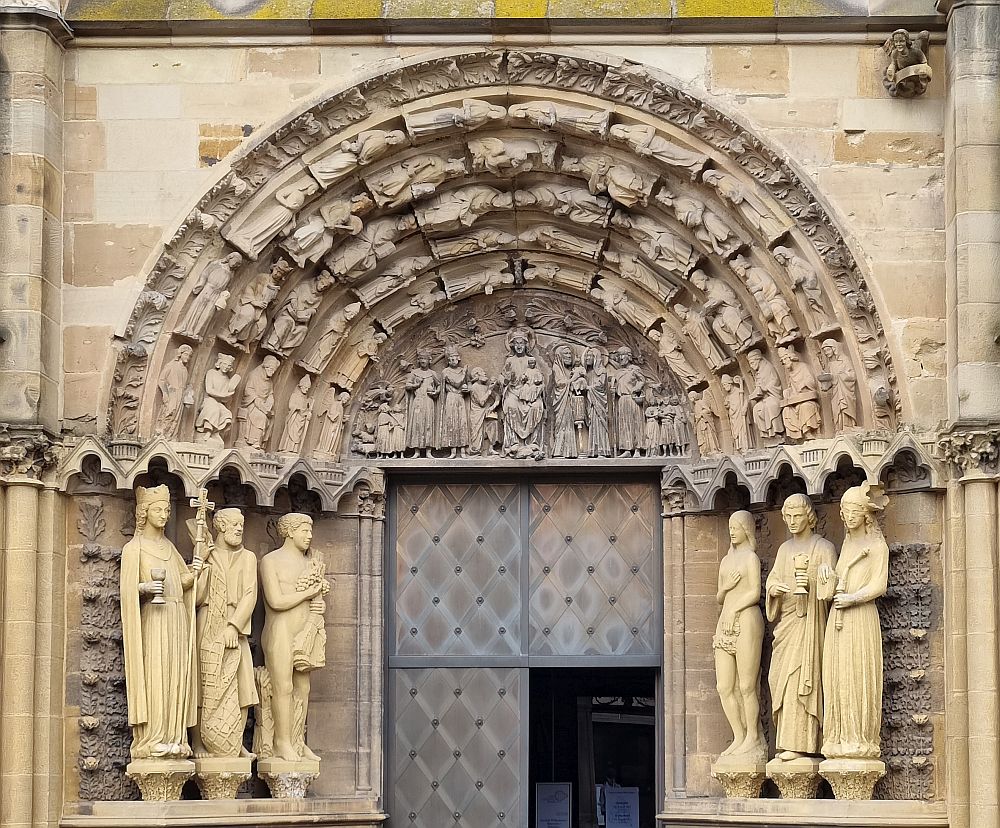
Liebfrauenkirche: Liebfrauenstraße 2. Open daily 12:45-17:00. Closed during church services. Admission free. Website.
The Rheinisches Landesmuseum
This is not a Roman ruin. It’s a museum, but with lots of artifacts from the Trier Roman ruins and surrounding areas. I didn’t get very much time in the museum, but I saw enough to know it’s a great place to see the archeological finds culled from the various Roman sites. It has everything from Roman coins to statues and bas-reliefs, but the real highlight, to me, is the collection of mosaics from local sites. Some of them are in astoundingly good condition.
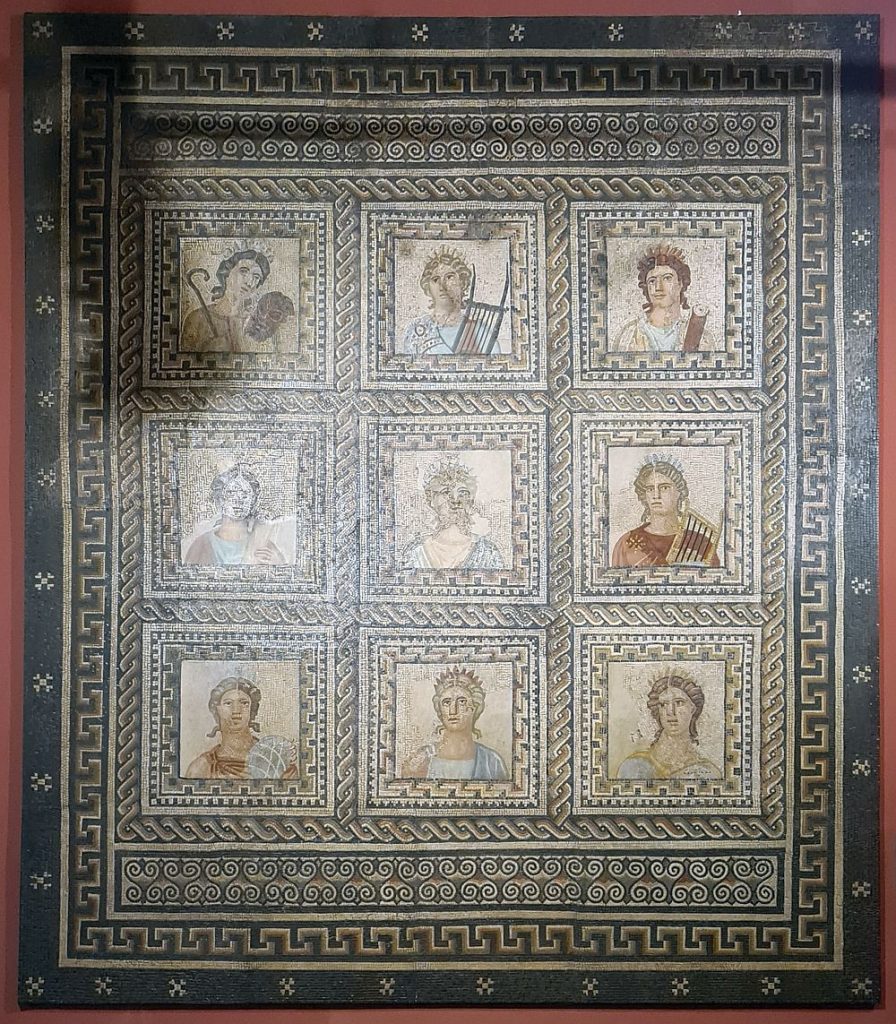
Note added September 2024: I was back in Trier recently and returned to the Landesmuseum to see their collection properly. It really is an outstanding collection – especially the detailed funeral statuary and, as I said above, the mosaics. There’s even an intact wall of a Roman villa, colorfully painted.
Rheinisches Landesmuseum: Weimarer Allee 1. Open Tuesday-Sunday 10:00-17:00. Admission: adults €8, children 7-18 €4. Includes audio guide. Website (in German; use Google translate).
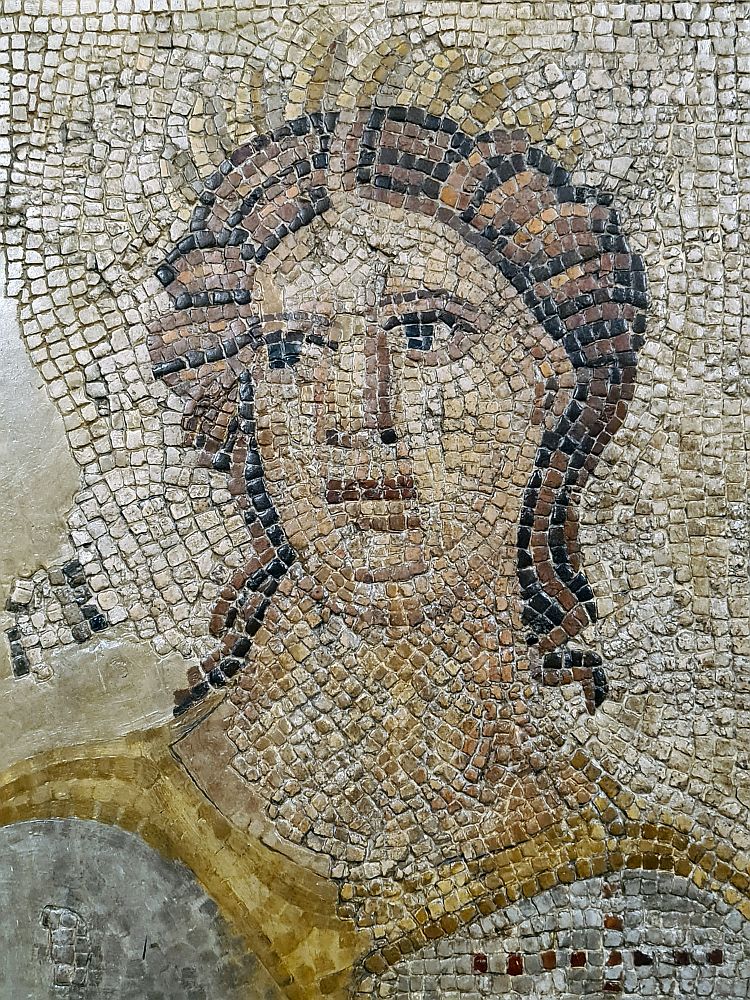
The Dom Museum
The Museum am Dom Trier is nearby the cathedral and contains a variety of Christian art pieces, from ancient to modern. I went there, on my later visit in summer 2024, to see some particular Roman paintings from the Constantian period. Where the cathedral now stands was once a palace, torn down in about 330 AD. to make way for a church. These paintings, which adorned the palace’s ceilings, were left in place, broken into more than 30,000 pieces, under the current cathedral’s floor.
Today, after years of piecing them back together, they are on display in the Dom Museum. There are more than 10, and they’re shown on walls, rather than on a ceiling. They portray things like “erotic couples” (though they don’t look erotic – they look like cherubs with wings. Perhaps a problem of translation?) and Eros and Psyche and busts of women.
The Dom Museum: Platz der Menschenwürde 1. Open Monday-Saturday 9:00-17:00 and Sunday and public holidays 13:00-17:00. Website (in German; use Google translate).
Igel Column
The Igel Column is the only item in the UNESCO property that is outside of the city of Trier, so it requires some travel to get to its home in the village of Igel. Built of sandstone in the 3rd century and carved with various images, it was a funerary monument for two brothers from a wealthy cloth-merchant family.
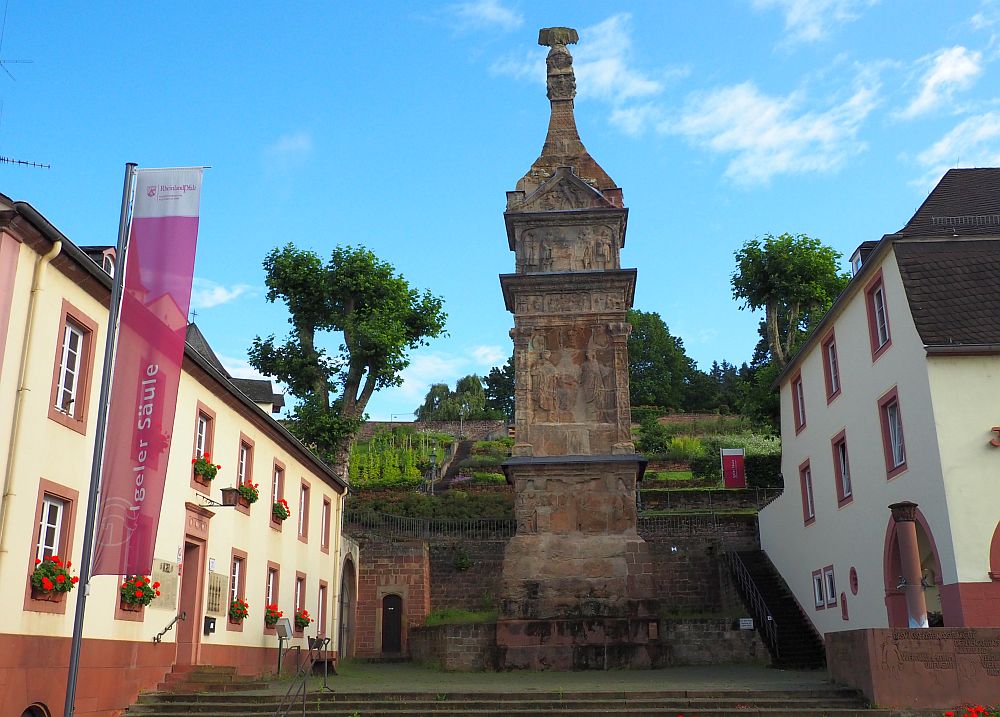
Igel is on the ancient military road between Trier and Reims, and apparently that meant that the monument served as an advertisement of sorts for this prominent family. The images show the merchants’ daily lives as well as some mythological scenes. While the Igel Column is far larger, you’ll see better-preserved funerary monuments in the Landesmuseum.
Igeler Säule: in the town of Igel, right next to the Hotel Igeler Säule on Trierer Straße 41. It is in a public space, so no admission fees or hours.
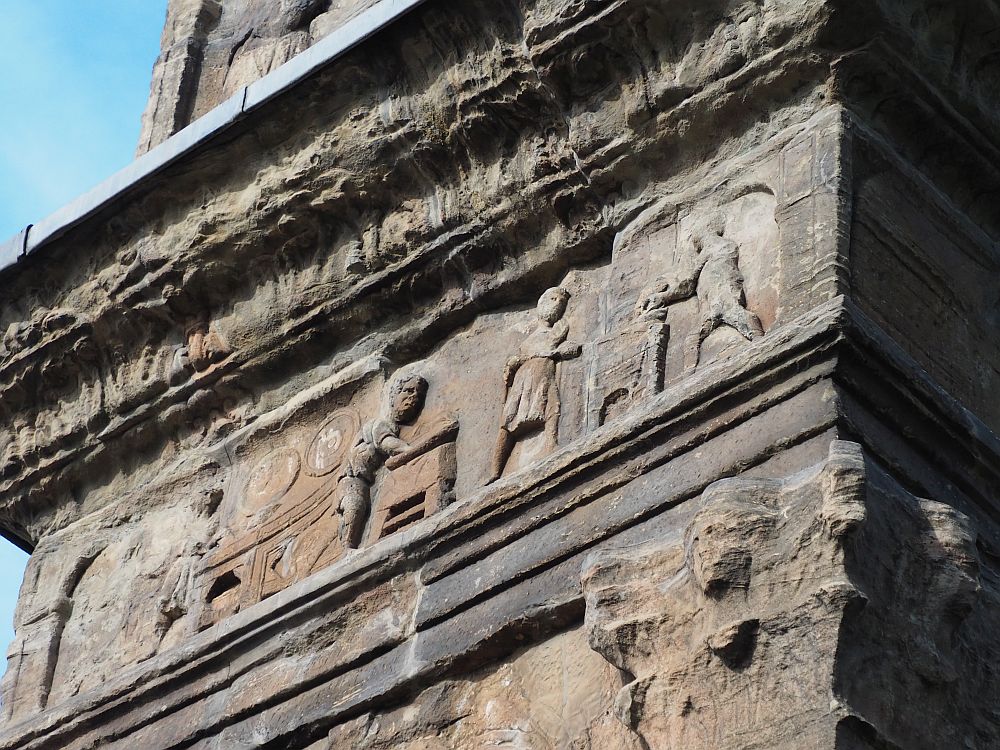
Which Trier Roman ruins should you see?
My husband and I stayed in Trier for two nights and were able to see all of these sights in a day and a half, except for the Igel Column, which we saw after our stay as we left the city, and the Dom Museum, which I saw on my later visit with a VIVA Cruise in 2024. I would recommend a bit more time; in the one late afternoon and one full day that we had, we saw all of the sights well except for the two museums. An extra half a day would have allowed a more relaxed and complete visit, including both museums.
I should also add that Trier is a pretty little city in its own right. It’s also home to the house in which Karl Marx was born, now a small Karl Marx museum.
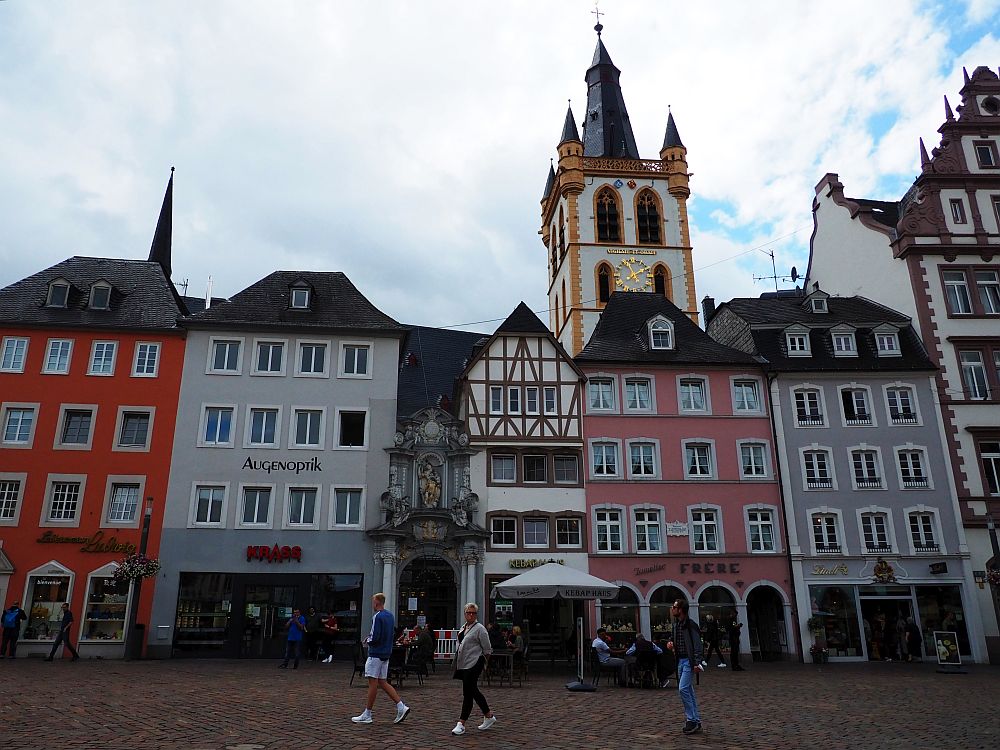
All of the Trier Roman ruins are within walking distance of each other, so your best bet is to find a place to stay within the center of town. I’d suggest three nights so you can have two full days to see the sights at your leisure. Use the map below to find your accommodations in Trier:
On the other hand, if you don’t have much time or only want to see the highlights, here are my top recommendations for Trier that you could see in a single day:
- The Porta Nigra is the real “must-see.” Don’t just look at it from the outside; pay the admission and see the inside too.
- Trier Cathedral and the Church of Our Lady are right next to each other so you might as well see both. It’ll show a range of early to late-medieval architectural detail, plus some Baroque-period artwork.
- The Museum has all of the best pieces from the Roman ruins of Trier. The mosaics alone are worth the trip.
Have you been to Trier? Do you have any advice or recommendations you could share? Leave a comment below!
(Updated September 5, 2024.)
My travel recommendations
Planning travel
- Skyscanner is where I always start my flight searches.
- Booking.com is the company I use most for finding accommodations. If you prefer, Expedia offers more or less the same.
- Discover Cars offers an easy way to compare prices from all of the major car-rental companies in one place.
- Use Viator or GetYourGuide to find walking tours, day tours, airport pickups, city cards, tickets and whatever else you need at your destination.
- Bookmundi is great when you’re looking for a longer tour of a few days to a few weeks, private or with a group, pretty much anywhere in the world. Lots of different tour companies list their tours here, so you can comparison shop.
- GetTransfer is the place to book your airport-to-hotel transfers (and vice-versa). It’s so reassuring to have this all set up and paid for ahead of time, rather than having to make decisions after a long, tiring flight!
- Buy a GoCity Pass when you’re planning to do a lot of sightseeing on a city trip. It can save you a lot on admissions to museums and other attractions in big cities like New York and Amsterdam.
- Ferryhopper is a convenient way to book ferries ahead of time. They cover ferry bookings in 33 different countries at last count.
Other travel-related items
- It’s really awkward to have to rely on WIFI when you travel overseas. I’ve tried several e-sim cards, and GigSky’s e-sim was the one that was easiest to activate and use. You buy it through their app and activate it when you need it. Use the code RACHEL10 to get a 10% discount!
- Another option I just recently tried for the first time is a portable wifi modem by WifiCandy. It supports up to 8 devices and you just carry it along in your pocket or bag! If you’re traveling with a family or group, it might end up cheaper to use than an e-sim. Use the code RACHELSRUMINATIONS for a 10% discount.
- I’m a fan of SCOTTeVEST’s jackets and vests because when I wear one, I don’t have to carry a handbag. I feel like all my stuff is safer when I travel because it’s in inside pockets close to my body.
- I use ExpressVPN on my phone and laptop when I travel. It keeps me safe from hackers when I use public or hotel wifi.



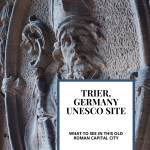
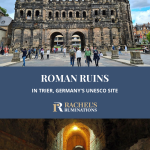

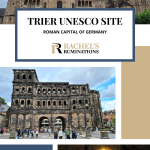

Good summary of some of the highlights of my hometown. One of my favorites is the Basilica. It is absolutely impressive to imagine standing in the throne room of Emperor Constantine.
Yes, the sheer size of it is pretty awe-inspiring, but it wasn’t my favorite, just because it’s so stripped-down now. Thanks for commenting!
I agree that the museum is worth a visit. The mosaics were wonderful.
Hey Rachel,
please let me note that Trier is located in the most western part of Germany. Perhaps you could change this in the introduction of your interesting blog.
Oops! I can’t believe I messed that up! Will change it now! Thanks for pointing it out!